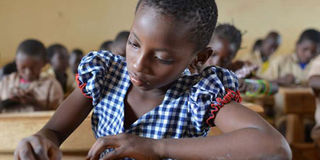Ivorians use schools to cut child labour

A pupil in a classroom in the first elementary school built in 2013 by Swiss group Nestle, in the village of Goboue, in the southwest of Ivory Coast on March 7, 2016. Cote d’Ivoire, the world’s largest cocoa producer, has struggled to prevent children working in the cocoa sector, long an accepted practice in the countryside. AFP PHOTO | ISSOUF SANOGO
What you need to know:
- In 2011, the west African country announced plans to spend almost 20 million euros (KSh2.2 billion) between 2015-2017 to reduce the number of minors working on plantations by 30 per cent by 2017 and 70 per cent by 2020.
- Since 2011, 17,829 classrooms have been built or restored, according to the National Monitoring Committee (CNS), which is charged with overseeing the government’s anti-child labour efforts.
- It is hoped that the plan will break the cycle of children following their parents into the fields at a young age.
ABIDJAN, Wednesday
"At five years old, I went to work in the fields with my dad. Today, my children go to school,” said Peter, a cocoa farmer in Bonikro in the centre of Cote d’Ivoire.
Peter is one of a generation of farmers at the heart of a drive to keep the country’s children in school and away from its vast plantations.
Cote d’Ivoire, the world’s largest cocoa producer, has struggled to prevent children working in the cocoa sector, long an accepted practice in the countryside.
The industry, which accounts for 15 per cent of GDP and more than 50 per cent of export receipts as well as two thirds of the country’s jobs, is absolutely vital to the country’s economic welfare, according to the World Bank.
CHILD LABOUR
But criticism of its record on child labour by consumers and buyers has in the past threatened to tarnish cocoa from Cote d’Ivoire and undermine its main export, prompting authorities to act.
The government’s scheme to get children off the plantations and into school, launched in 2011, is as much about improving the country’s image overseas as it is about protecting its young people.
Sylvie Patricia Yao, the leader of the campaign and chief of staff to the country’s first lady, said that education would help limit child exploitation in the cocoa sector.
“(It) remains for us the alternative and the most effective response in the long-term fight against child labour,” she said.
In 2011, the west African country announced plans to spend almost 20 million euros (KSh2.2 billion) between 2015-2017 to reduce the number of minors working on plantations by 30 per cent by 2017 and 70 per cent by 2020.
CLASSROOMS BUILT
Since 2011, 17,829 classrooms have been built or restored, according to the National Monitoring Committee (CNS), which is charged with overseeing the government’s anti-child labour efforts.
It is hoped that the plan will break the cycle of children following their parents into the fields at a young age.
Djouha Gneprou, a cocoa planter in Goboue in the country’s west, is involved with a school opened by global food giant Nestle in 2013.
“Once the child is in school, they won’t have time to be in the field so they can’t do the heavy work,” he told AFP.
Despite the scheme, recent figures highlight the challenges in the battle. Between 300,000 and one million children are still estimated to work in the sector, according to a report by the International Cocoa Initiative (ICI), an organisation created by the chocolate industry to fight the exploitation of minors.
Some 4,000 child victims of “slavery and exploitation” were removed from cocoa plantations in Ivory Coast between 2012 and 2014, according to authorities.
Whether paid or unpaid, children often come from Ivory Coast’s neighbour Burkina Faso, and are used to carry heavy loads, fell trees and spray crops with pesticides.





